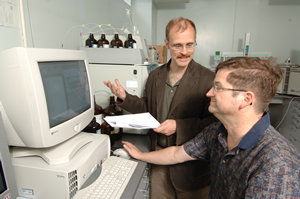
UNL's Water Sciences Lab is on the cutting edge of technology that tells us what's in the water and how much of it there is. The lab helps researchers answer questions about whether the water is safe to drink or to use to grow food.
"In the last 10 years, we've been doing a lot of work with emerging contaminants, that is, chemicals that we are just now able to measure with new technologies," said Dan Snow, director of the lab.
One such chemical is trenbolone, a synthetic androgen used on livestock. "There were concerns that metabolites of this chemical could end up in streams and potentially affect fish. However, it now appears very little trenbolone used in livestock production is getting off the feedlot," Snow said. "There are other naturally produced hormones and related compounds that do occur in runoff, but until we had the methods and technology to measure those compounds, there was no way you could answer that question."
Of potentially greater concern are traces of other chemicals that the lab detects in wastewater effluent, such as methamphetamine and certain antibiotics, though Snow hastened to add that meth is not likely to be at measurable levels in drinking water. The lab has also picked up traces of carbamazepine, an anticonvulsant, and the antihistamine diphenhydramine, both of which seem "pretty refractory – they don't seem to break down easily." Other studies have detected artificial sweeteners in municipal waste water, presumably because of the large amounts consumed and how slowly they break down.
Snow said a couple of other projects the lab is supporting are looking into the potential for antibiotic transport from livestock manure used as fertilizer on crops. "Biosolids are a great soil conditioner – either from human or animal waste – but this material also contains traces of biologically active chemicals, like pesticides, steroids and antibiotics," he said. "We're introducing them into the environment indirectly and inadvertently, and we don't always understand what the impact of that is. That's kind of an interesting question." Researchers are also exploring whether exposure to antibiotics in the environment increases the prevalence of antibiotic-resistant bacteria.
The Water Sciences Lab is a UNL Core Facility, meaning that its equipment belongs to and is shared by researchers across the institution. In 2011 the Water Sciences Laboratory processed almost 4,000 samples for tests, ranging from standard nutrient analyses to specialized methods for algal toxins and stable isotopes. Snow said about 80 percent of the research was for scientists from various disciplines across the university, and the other 20 percent was for federal, state and local agencies and others.
Equipment added in 2011 includes a Lachat Quikchem 8500 flow injection autoanalyzer, providing high throughput nutrient analyses. Snow said the Lachat analyzer, transferred from another unit and installed early in 2011, should help support new faculty research in both surface and groundwater quality by providing lower costs and more rapid turnaround of results for nutrient testing.
In addition to expanding the list of available equipment, the lab continually adds to the methods it uses to detect environmental chemicals, and each sample type uses its own method, Snow said.
Among the methods developed in 2011 are several ways to detect specific algal neurotoxins thought to occur seasonally in blue-green algae or cyanobacteria. One of the compounds it can detect -- anatoxin-a -- is an amine alkaloid with known acute neurotoxicity causing paralysis and respiratory arrest in exposed animals, Snow said. This method was developed by an environmental toxicology graduate student for his research on neurotoxins in lake water, fish and aquatic plants, and is in addition to a liquid chromatography-mass spectrometry (LC/MS) method for microcystins commonly found in area lakes.
The lab also offers a method to help determine sources of nitrate and phosphate contamination in surface or groundwater, using oxygen isotope (oxygen-18) analysis. Runoff from fertilized crops and lawns contributes to high levels of these nutrients in waterways and groundwater, and using isotopes helps determine which sources are most important.
Besides water quality and water chemistry, Snow said, the laboratory supports research in hydrology and physical hydrology. Isotope analysis can tell researchers the age of water, which can help determine the recharge rate of aquifers.
The Water Sciences Laboratory is now preparing for a new state-of-the-art noble gas mass spectrometer and high vacuum gas purification system. A major research instrumentation grant, awarded in 2011, will fund the purchase of a Thermo Helix SFT noble gas mass spectrometer to be used for analysis of helium isotopes in ground water age-dating, Snow said. Helium-tritium age-dating is one of a very few methods available for accurate estimation of recently (less than 50 years) recharged groundwater.
"Few labs in North America currently have this capability," Snow said. "It is expected that NU faculty will be able to leverage the new technology to expand support research focused on water resource renewability, water quality, and dynamic earth systems. It’s an exciting time to be studying water."
For a detailed list of the lab's capabilities, please see http://research.unl.edu/facultyresources/coreFacility_details.php?VCRCoreFacilityUnitID=7 or refer to the Water Science Laboratory's website.
More details at: http://go.unl.edu/mr3